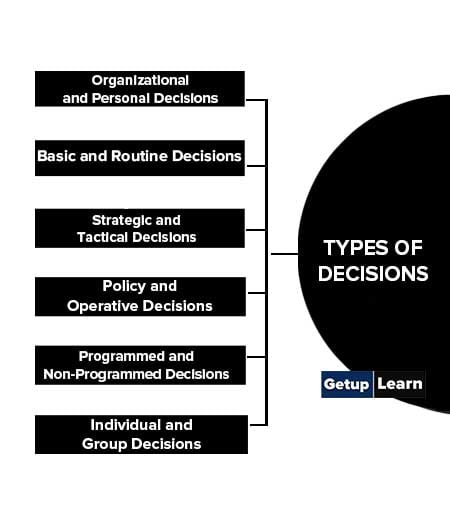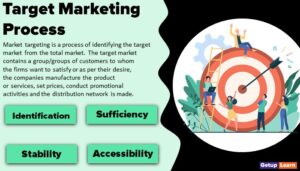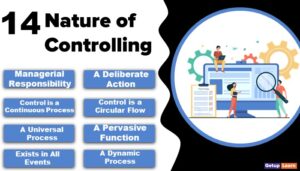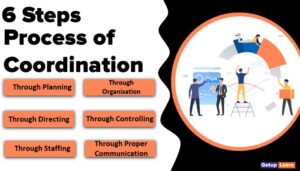Table of Contents
- 1 What is Decision Making?
- 2 Definition of Decision Making
- 3 Characteristics of Decision Making
- 4 Types of Decisions
- 5 Features of Decision Making
- 6 Decision Making Process
-
7 Importance of Decision Making
- 7.1 Implementation of Managerial Function
- 7.2 Pervasiveness of Decision Making
- 7.3 Evaluation of Managerial Performance
- 7.4 Helpful in Planning and Policies
- 7.5 Selecting Best Alternatives
- 7.6 Successful Operation of Business
- 7.7 Facilitate Innovation
- 7.8 Indispensable Component
- 7.9 Motivates Employees
- 7.10 Quick Decisions
- 7.11 Evaluation of Managerial Function
-
8 FAQ Related to Decision Making
- 8.1 What is the meaning of decision making?
- 8.2 What is the definition of Decision Making?
- 8.3 What are the characteristics of decision making?
- 8.4 What are the types of decisions?
- 8.5 What are the features of decision making
- 8.6 What are the steps of the decision-making process?
- 8.7 What is the importance of decision making?
What is Decision Making?
Decision making is a process of selecting the best course of action from among the alternative course of action. Decisions must be rationally taken after careful analysis of the problem.
Rational decision making, therefore, involves a conscious choice on the part of the managers of a particular course of action out of many available alternatives.
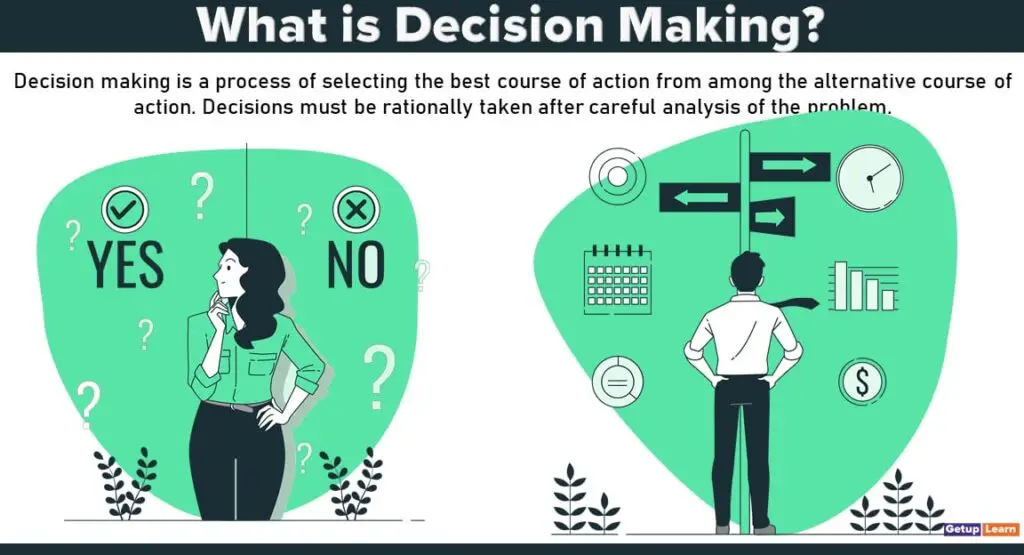
In other words, Decision Making is an integral part of management that is at the core of planning and applied in every function of management. Peter F. Drucker has rightly said, “Whatever a manager does he does through decision-making”.
Managers at all levels are engaged in the decision making of one kind or the other, Management and decision making go hand in hand. Every manager constantly makes decisions. Decision making is a combination of thinking, deciding, and action.
Definition of Decision Making
These are the best and most simple definitions of decision making by authors:
[su_quote cite=”Geroge R. Terry”]Decision making is the selecting of an alternative from two or more alternatives to determine an opinion or course of action.[/su_quote]
[su_quote cite=”Louis A. Allen”]Decision making is the work that a manager performs to arrive at conclusion and judgment.[/su_quote]
[su_quote cite=”Koontz and O’ Donnell”]Decision making is the actual selection from among alternatives of a course of action.[/su_quote]
[su_quote cite=”Dr. R.K. Singla”]Decision making involves the selection of the best available alternatives as a solution of some problem.[/su_quote]
[su_quote cite=”Mcfarland”]A decision is an act of choice wherein an executive forms a conclusion about what must be done in a given situation. A decision represents a course of behavior chosen from a number of possible alternatives[/su_quote]
[su_quote cite=”Henry Sisk and Cliffton Williams”]A decision is the selection of a course of action from two or more alternatives; the decision making process is a sequence of steps leading to that selection”. From these definitions, it is quite clear that decisions take place prior to the actual performance of a course of action that has been chosen.[/su_quote]
Characteristics of Decision Making
The important characteristics of decision making may be listed thus:
- Goal Oriented
- Alternative
- Analytical Intellectual
- Dynamic Process
- Pervasive Function
- Continuous Activity
- Commitment of Time, Effort and Money
- Human and Social Process
- Integral Part of Planning
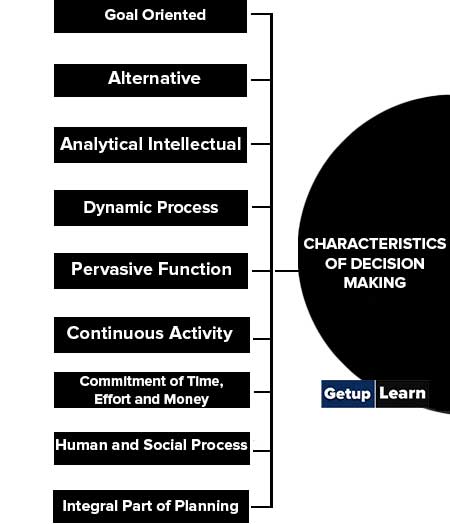
Goal Oriented
Decision making is a goal-oriented process. Decisions are usually made to achieve some purpose or goal. The intention is to move towards some desired state.
Alternative
A decision should be viewed as „a point reached in a stream of action.? It is characterized by two activities- search and choice. The manager searches for opportunities, to arrive at decisions and for alternative solutions, so that action may take place.
Selecting an alternative and abiding by it leads to decision making. Thus, an alternative is found fit to solve a particular problem. When no alternatives exist, the manager does not need to arrive at a decision.
When uncertainty concerning a particular outcome is confronted, the manager has no choice but to put on his decision making hat.
Analytical Intellectual
Decision making is not only an intellectual process but also an intuitive one. It involves conscious and unconscious aspects. Part of it can be learned, but part of it depends upon the personal characteristics of the decision maker.
Dynamic Process
Decision making is characterized as a process, rather than as one static entity. It is a process of using inputs effectively in the solution of selected problems and the creation of outputs that have utility. Moreover, it is a process concerned with „identifying worthwhile things to do. in a dynamic setting.
Pervasive Function
Decision making permeates all management and covers every part of an enterprise. Decision making is the crux of a manager’s job. Everything that the manager does is backed by the power of decision making.
Continuous Activity
The life of a manager is a perpetual choice-making activity. He decides things on a continual and regular basis. It is not a one-shot deal.
Commitment of Time, Effort and Money
Decision-making implies the commitment of time, effort, and money. The commitment may be short-term or long-term, depending on the type of decision (e.g. strategic, tactical, or operating). Once a decision is made, the organization moves in a specific direction in order to achieve its goals.
Decision-making is a human and social process involving intellectual abilities, intuition, and judgment. The human, as well as social impacts of a decision, are usually taken into account while making the choice from several alternatives.
For example, in a labor-surplus, capital-hungry country like India, managers cannot suddenly shut down plants, lop off divisions and decide to lay off thousands of workers in the face of intense competition.
Integral Part of Planning
As Koontz indicated, „decision making is the core of planning.? Both are intellectual processes, demanding discretion and judgment. Both aim at achieving goals. Both are situational in nature.
Both involve choice among-alternative courses of action. Both are based on forecasts and assumptions and on future risk and uncertainty.
Types of Decisions
These are the following types of decisions explained below:
- Organizational and Personal Decisions
- Basic and Routine Decisions
- Strategic and Tactical Decisions
- Policy and Operative Decisions
- Programmed and Non-Programmed Decisions
- Individual and Group Decisions
Organizational and Personal Decisions
Organizational decisions are made by managers in their official or formal roles. Such decisions can be, and frequently are, delegated to subordinates. Such decisions affect the functioning of the organization directly.
On the other hand personal decisions are those taken by managers as individuals. Such decisions pertain to the managers’ non-official personal life, e.g., decisions about career development, training, etc.
These decisions cannot be delegated. Further, most of these decisions also affect the organization, as in the case of a director deciding to resign. Though many managers seem to view their personal and organizational decisions separately, the two are so interwoven that it is difficult to separate them.
Basic and Routine Decisions
Basic decisions are unique one-time decisions involving long-range and relatively permanent commitments such as large investment decisions in which a mistake might seriously hurt the organization.
They are of crucial importance and often difficult to decide. On the other hand, routine decisions are routine and repetitive relatively with little deliberation and tend to have only a minor effect on the functioning of the organization.
Strategic and Tactical Decisions
Peter F. Drucker distinguishes between strategic and tactical decisions. Strategic decisions are made by top management and relate to the overall direction of the organization and resource commitments.
Tactical decisions are routine decisions taken in the course of day-to-day operations of the organization. This classification more or less resembles earlier classifications into basic and routine decisions.
Policy and Operative Decisions
Policy decisions are of vital importance and are taken by top management. They affect the entire enterprise. In contrast, operative decisions are taken by the lower management to put into action the policy decisions.
Programmed and Non-Programmed Decisions
This distinction has been made by Herbert A. Simon. Decisions are programmed to the extent that they are repetitive and routine and to the extent that systematic procedures are devised so that each one does not have to be treated as a unique case.
Non-programmed decisions are non-repetitive -and basic in nature. They are novel, unstructured, ill-structured, or consequential.
Individual and Group Decisions
As the name suggests, individual decisions are taken by a single individual, whereas group decisions are made by a group of individuals like the Board of Directors, problem-solving groups, management peers, committees, etc.
Features of Decision Making
These are the important features of decision making given below:
- Goal Oriented Process
- Continuous Process
- A Selective Process
- Human and Rational Process
- A Dynamic Process
- Positive or Negative Impact
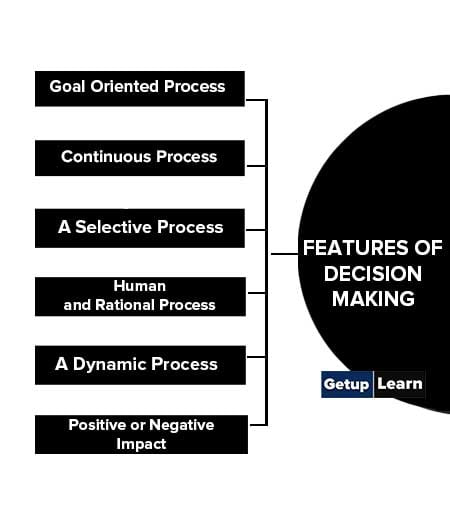
Goal Oriented Process
Decision Making is Goal Oriented Process: Decision making focuses on organizational objectives. In course of functioning, many problems may arise in the organization. The management has to solve all the problems in the proper time and also in a systematic manner by considering organizational goals.
Thus, the right decision at the right time contributes to achieving predetermined objectives within the defined time and standard.
Continuous Process
Decision Making is a Continuous Process: Decision making is a continuous process till the existence of the organization. In the course of regular performance, many problems may arise at different times and situations. Managers have to solve those problems in the proper time so that organizational performance is smooth.
A Selective Process
Decision Making is a Selective Process: Decision making is the process of selecting a course of action from among many alternatives to solve problems. Managers have to consider various factors before selecting a course of action.
These factors involve the nature of the organization, the existing working environment, the objectives of the organization, time factors, and so on.
Human and Rational Process
Decision Making in Human and Rational Process: Decision making is a mental or human process and is needed in all types of organizations. A manager has to make mental exercises to study the impact of the course of action before taking a decision.
He/she has to invest personal skills, experience, knowledge, and capability to study the course of action from various angles. Hence, decision making is common in all types of organizations. Therefore, it is known as a human and rational process.
A Dynamic Process
Decision Making is a Dynamic Process: It is essential to consider the time factors and existing environment, whenever any course of action is taken for implementation. Managers have to take decisions at the right time for their effectiveness.
Besides, they have to consider future environments, which may affect future activities. Thus, decision making process is not static but dynamic process.
Positive or Negative Impact
A course of action may either have a positive or negative impact on organizational performance. Managers have to consider, as far as possible, the positive impact of the action before coming to a decision.
Decision Making Process
These are the steps of decision making process each point explain below:
- Specific Objective
- Problem Identification
- Diagnosis
- Analysis
- Search for Alternatives
- Evaluation of Alternatives
- Choice of Alternative
- Action
- Results
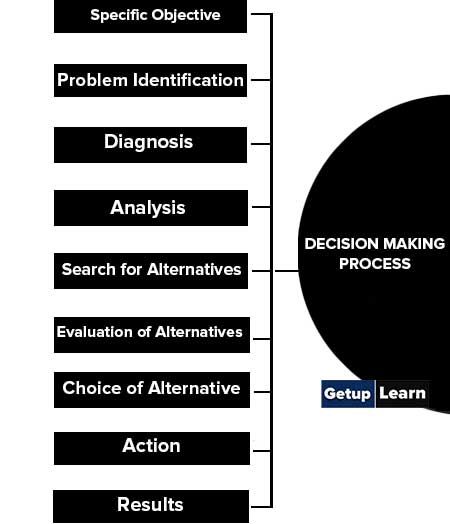
Specific Objective
The need for decision making arises in order to achieve certain specific objectives. The starting point in any analysis of decision making involves the determination of whether a decision needs to be made.
Problem Identification
A problem is a felt need, a question that needs a solution. In the words of Joseph L Massie “A good decision is dependent upon the recognition of the right problem”.
The objective of problem identification is that if the problem is precisely and specifically identified, it will provide a clue to finding a possible solution. A problem can be identified clearly if managers go through a diagnosis and analysis of the problem.
Diagnosis
Diagnosis is the process of identifying a problem from its signs and symptoms. A symptom is a condition or set of conditions that indicate the existence of a problem.
Diagnosing the real problem implies knowing the gap between what is and what ought to be, identifying the reasons for the gap, and understanding the problem in relation to the higher objectives of the organization.
Analysis
The diagnosis gives rise to analysis. Analysis of a problem requires:
- Who would make the decision?
- What information would be needed?
- From where the information is available?
Analysis helps managers to gain insight into the problem.
Search for Alternatives
A problem can be solved in several ways; however, all the ways cannot be equally satisfying.
Therefore, the decision maker must try to find out the various alternatives available in order to get the most satisfactory result of a decision. A decision maker can use several sources for identifying alternatives:
- His Own Past Experiences.
- Practices Followed by Others.
- Using Creative Techniques.
Evaluation of Alternatives
After the various alternatives are identified, the next step is to evaluate them and select the one that will meet the choice criteria, the decision maker must check proposed alternatives against limits, and if an alternative does not meet them, he can discard it.
Having narrowed down the alternatives which require serious consideration, the decision maker will go for evaluating how each alternative may contribute towards the objective supposed to be achieved by implementing the decision.
Choice of Alternative
The evaluation of various alternatives presents a clear picture of how each one of them contributes to the objectives under question. A comparison is made among the likely outcomes of various alternatives and the best one is chosen.
Action
Once the alternative is selected, it is put into action. The actual process of decision making ends with the choice of an alternative through which the objectives can be achieved.
Results
When the decision is put into action, it brings certain results. These results must correspond with objectives, the starting point of the decision process if the good decision has been made and implemented properly.
Thus, results provide an indication of whether decision making and its implementation are proper.
Importance of Decision Making
These are the importance of decision making:
- Implementation of Managerial Function
- Pervasiveness of Decision Making
- Evaluation of Managerial Performance
- Helpful in Planning and Policies
- Selecting Best Alternatives
- Successful Operation of Business
- Facilitate Innovation
- Indispensable Component
- Motivates Employees
- Quick Decisions
- Evaluation of Managerial Function
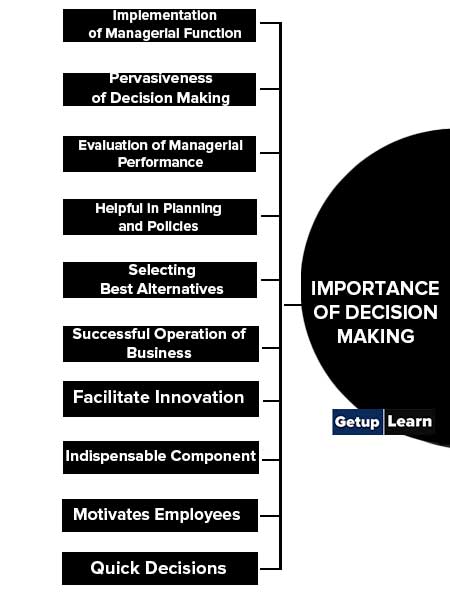
Implementation of Managerial Function
Without decision-making different managerial function such as planning, organizing, directing, controlling, staffing can’t be conducted.
In other words, when an employee does, she/he does the work through the decision making function. Therefore, we can say that decision is an important element to implement the managerial function.
Pervasiveness of Decision Making
The decision is made in all managerial activities and in all functions of the organization. It must be taken by all staff. Without decision-making, any kind of function is not possible. So it is pervasive.
Evaluation of Managerial Performance
Decisions can evaluate managerial performance. When the decision is correct it is understood that the manager is qualified, able and efficient. When the decision is wrong, it is understood that the manager is disqualified. So decision-making evaluates managerial performance.
Helpful in Planning and Policies
Any policy or plan is established through decision making. Without decision making, no plans and policies are performed. In the process of making plans, appropriate decisions must be made from so many alternatives. Therefore, decision making is an important process that is helpful in planning.
Selecting Best Alternatives
Decision making is the process of selecting the best alternatives. It is necessary for every organization because there are many alternatives. So decision-makers evaluate various advantages and disadvantages of every alternative and select the best alternative.
Successful Operation of Business
Every individual, department, and organization make the decisions. In this competitive world; an organization can exist when the correct and appropriate decisions are made. Therefore, correct decisions help in the successful operation of the business.
Facilitate Innovation
Rational decisions facilitate innovation. This is because it helps to develop new ideas, new products, new processes, etc. This results in innovation. Innovation gives a competitive advantage to the organization.
Indispensable Component
Decision making is known as an inseparable part of management functions. It is one of the essential processes for the successful operation of the business. It determines all management functions and covers every part of the organizational structure.
Every manager from the top level to the first line is involved in the decision making process according to the nature of work.
Motivates Employees
The rational decision results in motivation for the employees. This is because the employees are motivated to implement rational decisions. When rational decisions are implemented the organization makes high profits. Therefore, it can give financial and non-financial benefits to the employees.
Quick Decisions
Some decisions should be made quickly. Unfortunately, those are the ones that some business owners may agonize over for days or weeks. If a decision can be changed or undone without great cost, then it can be made quickly. The company can go broke while top management oscillates between using one office supply company over another.
Evaluation of Managerial Function
Decision making is a time-consuming process and decision makers spend more time selecting the alternative. The quality of decisions serves as the yardstick for evaluating managerial performance.
It provides a clear line of guidance to the management for the achievement of defined objectives. The achievement of managerial performance is evaluated and measured with planned performance.
What is the meaning of decision making?
Decision making involves the selection of the best available alternatives as a solution to some problem.
What is the definition of Decision Making?
Decision making is the actual selection from among alternatives for a course of action. By Koontz and O’ Donnell
What are the characteristics of decision making?
The following are the characteristics of decision making:
1. Goal Oriented
2. Alternative
3 Analytical Intellectual
4. Dynamic Process
5. Pervasive Function
6. Continuous Activity
7. Commitment of Time, Effort and Money
8. Human and Social Process
9. Integral Part of Planning.
What are the types of decisions?
The following are the types of decisions:
1. Organizational and Personal decisions
2. Basic and Routine Decisions
3. Strategic and Tactical Decisions
4. Policy and Operative Decisions
5. Programmed and Non-Programmed Decisions
6. Individual and Group Decisions.
What are the features of decision making
The following are the features of decision making:
1. Goal Oriented Process
2. Continuous Process
3. A Selective Process
4. Human and Rational Process
5. A Dynamic Process
6. Positive or Negative Impact.
What are the steps of the decision-making process?
Following are the steps of the decision-making process:
1. Specific Objective
2. Problem Identification
3. Diagnosis
4. Analysis
5. Search for Alternatives
6. Evaluation of Alternatives
7. Choice of Alternative
8. Action
9. Results.
What is the importance of decision making?
The following are the importance of decision making:
1. Implementation of Managerial Function
2. Pervasiveness of Decision Making
3. Evaluation of Managerial Performance
4. Helpful in Planning and Policies
5. Selecting Best Alternatives
6. Successful Operation of Business
7. Facilitate Innovation
8. Indispensable Component
9. Motivates Employees
10. Quick Decisions
11. Evaluation of Managerial Function.

